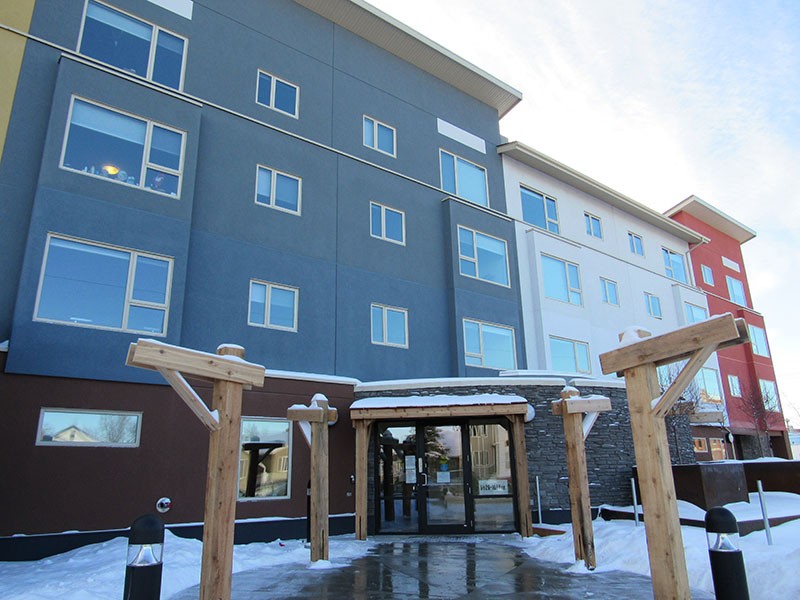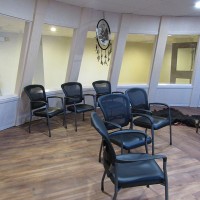Ambrose Place Opens
Facility to meet the unique housing needs of Aboriginal people.

After several years and a couple of legal battles, Ambrose Place is finally set to open officially this month.
Ambrose Place is named after Ambrose Daniels, an Aboriginal man who died of pneumonia while living on the street. The facility is intended to provide housing and support services within a culturally sensitive environment to homeless individuals and couples of Aboriginal descent who have not been successfully housed in existing facilities, as well as urban Aboriginals who do not require supports. Twenty eight units on the second and third floors will be supportive housing, while the 14 units on the fourth floor will be available for those seeking safe, affordable housing. Residents will be able to move from the supportive housing to independent living in the affordable housing units while remaining within their existing community.
The facility has been operating since December, and its grand opening is scheduled for February 27. Located at 9637 106 Avenue, Ambrose Place is the first project of Niginan Housing Ventures. Niginan (which means “home”) is a registered charity formed to address the needs and requirements of Aboriginal people living in Edmonton, especially through providing supportive affordable housing opportunities for individuals and families who have not been successfully served by any other organization in Edmonton.
The facility will operate using a harm reduction model. Harm reduction “refers to policies, programs, and practises that aim to reduce the harms associated with use of drugs or alcohol in people unwilling and/or unable to stop. The focus is on the prevention of harm rather that the prevention of use,” explains Carola Cunningham, Executive Director of Niginan.
Cunningham cites that harm reduction is doable. “Many people drink and use drugs to survive the harsh life of the streets and living homeless. Ambrose Place will provide security, shelter, and food (often traditional food when available). This allows the individual to then focus on their health physically, emotionally, spiritually, and mentally. The Ambrose team will then provide a collective community and programming that enhance and empowers individual choice,” she says.
One of the things Ambrose Place will provide is spiritual and cultural support to those who want it. “All spiritual beliefs are welcomed and honoured; no one is expected to follow the Red Road unless it is their choice,” says Cunningham. “The board members had the foresight to design and construct a ceremonial room in Ambrose Place that will allow the residents to join in daily smudging. Various ceremonies will be hosted by visiting Elders at the proper times of the year; drumming and singing groups will be initiated and encouraged.”
Yearly medicine picking, attending sweats, Sundances, and fasting lodges will be accessed in the community,” Cunningham continues. “We will also have in house Elders on site, to perform individual ceremonies and counselling and teaching opportunities.”
Having Elders on site is important because “Indigenous people view mental illness through a different lens than Western society and the Elders have a way of drawing individual gifts out of our people. They also bring a calming influence to everyone when they are on site. People tend to treat and speak with on another in a peaceful and respectfully way,” Cunningham explains.
Ambrose Place is in the Chinatown area of the McCauley neighbourhood. The McCauley Community League, concerned about the overabundance of social housing in the area, took Niginan to court twice to stop the development of Ambrose Place. Twice, the community league was unsuccessful, with the final appeal being in late October of 2012.
The court battles, among other issues, left Niginan financially strapped. The Edmonton Inner City Housing Corporation (EICHS) stepped in with financial help. “The Edmonton Inner City Housing Society became aware that Niginan Housing Ventures was looking to partner with an established, financially sound charitable housing provider with strong connections in the inner city and the not for profit housing sector,” says Cam MacDonald, Executive Director of EICHS. “Given the delays finishing construction, and the associated increases in interest and carrying costs, Niginan was faced with a cash flow shortage in order to finish construction. We were pleased to be able to cover the shortfall and become managing partners with a view to being part of the long term success of Ambrose Place.”
He continues, “From Inner City Housing’s point of view, we see Ambrose Place as an important part of the solution addressing the issue of overcoming homelessness in the inner city. Moreover, we see real social value in the fact that Ambrose Place will be providing culturally sensitive supports for the formerly homeless Aboriginal people that will be living at Ambrose Place.”
In March of 2014 an entirely new community league was elected in McCauley at its AGM. “The McCauley Community League continues to support efforts to find housing for those who most need it. The league recognizes that the process surrounding this project coming into McCauley was difficult, and that some still wonder if another community may have been a more appropriate home,” says President Mike Van Boom, on behalf of the McCauley Community League. “However, the league is pleased that some of our most hard-pressed citizens will now have strong and safe supportive housing. We are also hopeful that this project will help reduce incidents of disorder in our streets and alleys.”
Martin Atkinson is a Housing Support Worker at Ambrose Place who previously worked with Boyle Street Community Services’ Winter Warming program and was the team leader for the Bissell Centre drop in for past three years. “My familiarity with participants [homeless people] helps me out because they know me and I know them.”
Atkinson says that Ambrose Place will help other agencies by taking the pressure off of them because it is finding homes for people. Although he has only been there a short time, he says the job is already very rewarding. “I get to see some of the people I have worked with before. Now being here for just a short period I can see a great big difference in their demeanour and their health.”
One of the people who now has a home thanks to Ambrose Place is Fred Piche (Cujo). Cujo, as he is known on the street, had lived on the street off and on for three and a half years, often travelling to Vancouver and back.
“It’s pretty good. It’s a home for me. A place to have a bed, stay clean, eat well. It’s a good place,” he says.
Cujo, who uses a walker, emphasizes how much Ambrose Place has helped him. “They look after me. It’s a roof over my head. The meals are good.” Cujo says he has also cut down on his drinking.
EICHS’ Executive Director Cam MacDonald views Ambrose Place as a way of improving the surrounding area. “Increasing the supply and improving the quality of affordable housing stock in an area that still has many substandard derelict housing units in it, serves to benefit the community and lift people out of poverty. We also see the homes provided in Ambrose Place as a way to ease some of the pressures that chronic homelessness places on a community,” he says.
Carola Cunningham, Niginan’s Executive Director, emphasizes that “Ambrose Place will endeavour to bring people home to their self-worth and cultural identity. We are confident that when we work and heal together through reclaiming our childhood, working through trauma, adhering to natural law, honouring spiritual practice, and living traditional values we will lift each other up.”




